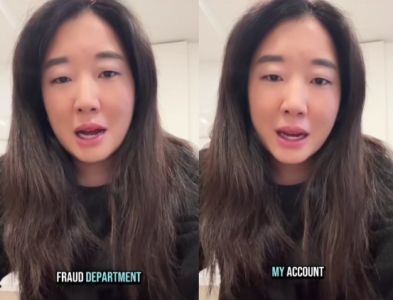Think your pay’s safe once it hits your account? Think again!
By
Maan
- Replies 0
Managing your money safely is more important than ever—especially as scams become more sophisticated and digital systems evolve.
But when fraud prevention measures create new problems for everyday customers, it raises difficult questions about how banks handle these situations.
One woman’s experience has sparked widespread concern about whether financial institutions are getting the balance right.
An ING customer was left locked out of her own bank account and without access to her funds after two everyday transactions triggered the bank’s fraud system—sparking renewed calls for financial institutions to rethink how they respond to suspected scams.
Katie McMaster, a personal assistant from Melbourne, said the experience left her feeling vulnerable and deeply frustrated after ING froze her account without warning.
She said the ordeal began on a Tuesday when she received an email from ING’s fraud department stating her account had been suspended due to ‘suspicious activity’.
Immediately reaching out to the bank, McMaster was told she wouldn’t be able to speak with anyone directly. Instead, she was informed that only the fraud team could resolve the issue, and they could only be contacted via email.
The 35-year-old was then instructed to verify her identity by replying to the email with her full name, date of birth and mobile number.
‘I just thought that was insane in itself to be sending that data across email to verify. For a bank of their size, I just thought that shouldn't be the process, especially when you're trying to get in touch with the fraud department,’ she said.
She was later sent a verification text and asked to upload identification. But once she completed those steps, communication from the bank went silent.
McMaster said she was told it could take up to two business days for the fraud team to respond—leaving her unable to use her debit card, withdraw cash or access her savings.
‘It was stressful in the fact that I could obviously see the balance, but the available balance was zero,’ she said.
While she couldn’t touch her savings, her ING credit card remained active—leaving her with no choice but to rely on it for daily expenses, despite the risk of accruing interest.
She continued: ‘But what was sort of frustrating was that they didn't block my credit card with them. They were happy for me to keep using my credit card, but then I would have to pay interest on that, but they wouldn't let me access my funds, and I couldn't withdraw any cash.’
The situation dragged on until 5:00 pm on Thursday, when McMaster finally received another email from ING asking her to confirm the legitimacy of two flagged transactions.
One was her regular monthly salary—paid on the same day each month. The other was a $300 transfer from a friend to cover tickets to see Usher.
After confirming both payments, McMaster received a phone call from the bank’s fraud team, and her account was unblocked on the spot.
She said the staff member seemed unsure why the transactions were marked as suspicious and even apologised for the lengthy delay in resolving the issue.
According to McMaster, the employee mentioned she was the only person monitoring the fraud email inbox.
‘The lack of communication was frustrating me the most. I understand banks have their processes, but I’d rather sit on hold for an hour knowing I’d get through than wait a couple of days,’ she said.
An ING spokesperson shared that protecting customers’ identities and funds was a central focus for the bank.
‘When our systems detect suspicious transactions, we proactively act on behalf of customers to protect their funds. This often involves temporarily placing a hold on a customer’s account until we can confirm the transactions with the customer,’ they said.
‘To reactivate account activity, we verify the customer’s identity through our secure fraud portal. During this process, the customer’s biometrics are matched against the identity documents we securely hold on record.’
‘We recognise that temporarily pausing activity on an account can impact customers, so we always check they have access to essential funds, ensuring they are not placed in financial hardship.’
McMaster’s decision to share her experience online quickly struck a chord, with many Australians sharing similar stories across social media.
Source: TikTok/katiekmc
‘This happened to me in 2019, I was overseas and there was no help. For the rest of my trip I had to use a friend’s money to be able to pay for anything. They cancelled the card and that was it,’ one person wrote.
‘Same happened with me! You feel so vulnerable not being able to get access to money! Luckily, I was able to borrow cash from someone because you literally can’t get access to any money, it’s crazy,’ another said.
‘It’s actually terrifying that they can do this,’ a third added.
Many also expressed concern over the email-based verification process, with some describing it as risky and contradictory to standard fraud prevention advice.
‘I’d refuse to send personal details over email, that’s ridiculous!!’ one said.
‘It’s a very odd process for fraud verification, and goes against our basic security instincts...It adds even more stress and confusion to the situation,’ another shared.
McMaster said she planned to move her banking to another institution and would consider spreading her money across multiple accounts to avoid facing the same issue again.
She urged banks to reassess their fraud protocols, particularly when it comes to asking customers to click links and upload personal documents via text and email.
‘The main concern of all of this is the verification process. It was just having to click on a link to upload my ID from a text message. It's just everything we're told not to do,’ she said.
She also reminded others to be extra cautious when handling any unexpected messages from banks and to verify their legitimacy before responding.
Katie later shared more about what happened.
Source: TikTok/katiekmc
Katie didn’t stop there—she opened up further about what the experience was really like.
Source: TikTok/katiekmc

With more Aussies turning to online banking, do you think the current fraud safeguards are doing more harm than good? Let us know your thoughts in the comments.
In an earlier story, we looked at how a Melbourne woman was locked out of her account for days after ING flagged two everyday transactions.
For older Aussies relying on digital banking, these experiences highlight just how vulnerable we can be when something goes wrong—and how slowly some banks respond.
If you’ve ever felt powerless waiting on a bank to fix their own mistake, you might want to give that one a read too.
Read more: ING customer locked out of her own money after ‘suspicious’ salary payment
But when fraud prevention measures create new problems for everyday customers, it raises difficult questions about how banks handle these situations.
One woman’s experience has sparked widespread concern about whether financial institutions are getting the balance right.
An ING customer was left locked out of her own bank account and without access to her funds after two everyday transactions triggered the bank’s fraud system—sparking renewed calls for financial institutions to rethink how they respond to suspected scams.
Katie McMaster, a personal assistant from Melbourne, said the experience left her feeling vulnerable and deeply frustrated after ING froze her account without warning.
She said the ordeal began on a Tuesday when she received an email from ING’s fraud department stating her account had been suspended due to ‘suspicious activity’.
Immediately reaching out to the bank, McMaster was told she wouldn’t be able to speak with anyone directly. Instead, she was informed that only the fraud team could resolve the issue, and they could only be contacted via email.
The 35-year-old was then instructed to verify her identity by replying to the email with her full name, date of birth and mobile number.
‘I just thought that was insane in itself to be sending that data across email to verify. For a bank of their size, I just thought that shouldn't be the process, especially when you're trying to get in touch with the fraud department,’ she said.
She was later sent a verification text and asked to upload identification. But once she completed those steps, communication from the bank went silent.
McMaster said she was told it could take up to two business days for the fraud team to respond—leaving her unable to use her debit card, withdraw cash or access her savings.
‘It was stressful in the fact that I could obviously see the balance, but the available balance was zero,’ she said.
While she couldn’t touch her savings, her ING credit card remained active—leaving her with no choice but to rely on it for daily expenses, despite the risk of accruing interest.
She continued: ‘But what was sort of frustrating was that they didn't block my credit card with them. They were happy for me to keep using my credit card, but then I would have to pay interest on that, but they wouldn't let me access my funds, and I couldn't withdraw any cash.’
The situation dragged on until 5:00 pm on Thursday, when McMaster finally received another email from ING asking her to confirm the legitimacy of two flagged transactions.
One was her regular monthly salary—paid on the same day each month. The other was a $300 transfer from a friend to cover tickets to see Usher.
After confirming both payments, McMaster received a phone call from the bank’s fraud team, and her account was unblocked on the spot.
She said the staff member seemed unsure why the transactions were marked as suspicious and even apologised for the lengthy delay in resolving the issue.
According to McMaster, the employee mentioned she was the only person monitoring the fraud email inbox.
‘The lack of communication was frustrating me the most. I understand banks have their processes, but I’d rather sit on hold for an hour knowing I’d get through than wait a couple of days,’ she said.
An ING spokesperson shared that protecting customers’ identities and funds was a central focus for the bank.
‘When our systems detect suspicious transactions, we proactively act on behalf of customers to protect their funds. This often involves temporarily placing a hold on a customer’s account until we can confirm the transactions with the customer,’ they said.
‘To reactivate account activity, we verify the customer’s identity through our secure fraud portal. During this process, the customer’s biometrics are matched against the identity documents we securely hold on record.’
‘We recognise that temporarily pausing activity on an account can impact customers, so we always check they have access to essential funds, ensuring they are not placed in financial hardship.’
McMaster’s decision to share her experience online quickly struck a chord, with many Australians sharing similar stories across social media.
Source: TikTok/katiekmc
‘This happened to me in 2019, I was overseas and there was no help. For the rest of my trip I had to use a friend’s money to be able to pay for anything. They cancelled the card and that was it,’ one person wrote.
‘Same happened with me! You feel so vulnerable not being able to get access to money! Luckily, I was able to borrow cash from someone because you literally can’t get access to any money, it’s crazy,’ another said.
‘It’s actually terrifying that they can do this,’ a third added.
Many also expressed concern over the email-based verification process, with some describing it as risky and contradictory to standard fraud prevention advice.
‘I’d refuse to send personal details over email, that’s ridiculous!!’ one said.
‘It’s a very odd process for fraud verification, and goes against our basic security instincts...It adds even more stress and confusion to the situation,’ another shared.
McMaster said she planned to move her banking to another institution and would consider spreading her money across multiple accounts to avoid facing the same issue again.
She urged banks to reassess their fraud protocols, particularly when it comes to asking customers to click links and upload personal documents via text and email.
‘The main concern of all of this is the verification process. It was just having to click on a link to upload my ID from a text message. It's just everything we're told not to do,’ she said.
She also reminded others to be extra cautious when handling any unexpected messages from banks and to verify their legitimacy before responding.
Katie later shared more about what happened.
Source: TikTok/katiekmc
Katie didn’t stop there—she opened up further about what the experience was really like.
Source: TikTok/katiekmc
Key Takeaways
- Katie McMaster’s ING account was frozen after two normal transactions triggered a fraud alert, leaving her unable to access her own money.
- She was asked to verify her identity through email and text, then heard nothing for days while still being allowed to use her credit card.
- The issue was resolved only after she confirmed her salary and a payment from a friend, with ING later admitting only one person monitored fraud emails.
- McMaster and others criticised the bank’s verification process, warning it contradicts common fraud advice and creates unnecessary stress.
With more Aussies turning to online banking, do you think the current fraud safeguards are doing more harm than good? Let us know your thoughts in the comments.
In an earlier story, we looked at how a Melbourne woman was locked out of her account for days after ING flagged two everyday transactions.
For older Aussies relying on digital banking, these experiences highlight just how vulnerable we can be when something goes wrong—and how slowly some banks respond.
If you’ve ever felt powerless waiting on a bank to fix their own mistake, you might want to give that one a read too.
Read more: ING customer locked out of her own money after ‘suspicious’ salary payment








